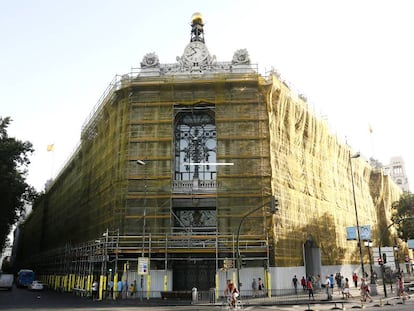Bank of Spain finally set to clarify role in handling of financial crisis
Governor says time has come for “an overall view” of its actions between 2008 and 2012
Luis María Linde, the governor of Spain’s central bank, has for the first time said the moment has come for “an overall view of the Bank of Spain’s actions during the period 2008-2012,” at the height of the financial crisis.

In an article published in EL PAÍS this Friday, Linde, who took over as governor in June 2012, points out that the central bank has provided information throughout the crisis, but now says a global analysis is required, although he doesn’t detail what form this should take.
“With the crisis over and the new European supervision [system] stabilized – and within this framework, the supervision of the Bank of Spain – this is surely the moment to offer an overall vision of the Bank of Spain’s actions during the period 2008-2012,” says the governor in his article, which comes in response to a recent editorial in this paper calling for the central bank to clarify its role during the country’s financial crisis.
Linde has admitted that the Bank of Spain failed in many aspects of its handling of the crisis
Opposition parties Ciudadanos and Podemos have the support of the country’s largest opposition party, the Socialists (PSOE), in calling for a commission to look into the crisis, something that the ruling Popular Party (PP) has blocked to date.
Economy Minister Luis de Guindos said recently he is prepared to accept “what parliament decides.” The PP no longer enjoys an absolute majority in Congress, meaning that the commission that Linde seems to be indirectly calling for could now be set up.
The initiative comes in the wake of revelations that up to December 2015, the cost of restructuring Spain’s failed savings banks had risen to €60.7 billion, of which €41.8 billion was provided by the Fund for Orderly Bank Restructuring (FROB) and €18.9 billion from the banks’ Guarantee Deposit Fund, according to Spain’s Audit Office, which states in a report that the cost to the Spanish state and the sector “committed” to the banks so far has been €122.1 billion, but that the final cost will not be known until all the savings banks have been sold off.
Linde admits in his article in EL PAÌS that international and national institutions, including the Bank of Spain, committed “serious forecasting” errors during the crisis. But the governor says it is important to distinguish between mistakes and actions that might be subject to legal censure. “I have no reason to think that the Bank of Spain did not act according to the general interest and respecting the law, but this does not mean, naturally that it was right every time,” he says.
It now appears a parliamentary commission will be set up to look into the crisis
The governor’s stance follows criticism of the central bank’s actions in the past, although he has never taken a step such as that he is suggesting now. Linde admitted before Congress in July 2012, a month after he took office, that the Bank of Spain “acted with little decisiveness and insufficiently and inadequately; our supervision was not successful.”
The scandal over the crisis affecting Spain’s failed savings banks worsened because at the same time as the state was cutting basic public services, more and more taxpayers’ money was being poured into rescuing the savings banks. What’s more, close to 250 directors and board members of these banks have been investigated for their direct or indirect involvement in financial wrongdoing. Among these, the cases that have hit the headlines are the Caja de Ahorros del Mediterráneo (CAM), Bankia, the misuse of expenses credit cards by board members of savings banks, along with the mismanagement of Caja Castilla-La Mancha. In January, five executives from the NovaCaixagalicia savings bank were sent to jail for embezzlement.
Doubts remains over the Bank of Spain’s handling of the first years of the financial crisis. Earlier this week, EL PAÍS reported that the entity’s supervisory board massaged figures in the early months of the crisis, in 2008 in a bid to hide the extent of the savings banks’ debts due to their heavy investment in the property sector, which had collapsed.
An internal working group called the Technical Coordination Committee told inspectors not to demand compliance with the law from supervisory boards in refinancing mortgages and loans.
In 2013, the Bank of Spain’s Association of Inspectors criticized the attitude of the central bank toward malpractice in a report. “The habitual response to indications of crime is to look the other way,” the report concluded. Brussels also called for a “formal internal revision” of supervisory methods “with the aim of detecting deficiencies and introducing the required improvements.”
In September 2016, the the Bank of Spain admitted that €26.3 billion in state aid to the country’s banks will never be recovered, despite promising voters in 2012 that they would not foot the bill for the financial crisis.
English version by Nick Lyne.
Tu suscripción se está usando en otro dispositivo
¿Quieres añadir otro usuario a tu suscripción?
Si continúas leyendo en este dispositivo, no se podrá leer en el otro.
FlechaTu suscripción se está usando en otro dispositivo y solo puedes acceder a EL PAÍS desde un dispositivo a la vez.
Si quieres compartir tu cuenta, cambia tu suscripción a la modalidad Premium, así podrás añadir otro usuario. Cada uno accederá con su propia cuenta de email, lo que os permitirá personalizar vuestra experiencia en EL PAÍS.
¿Tienes una suscripción de empresa? Accede aquí para contratar más cuentas.
En el caso de no saber quién está usando tu cuenta, te recomendamos cambiar tu contraseña aquí.
Si decides continuar compartiendo tu cuenta, este mensaje se mostrará en tu dispositivo y en el de la otra persona que está usando tu cuenta de forma indefinida, afectando a tu experiencia de lectura. Puedes consultar aquí los términos y condiciones de la suscripción digital.











































